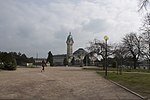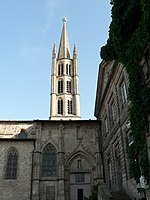Haute-Vienne
1790 establishments in FranceDepartments of Nouvelle-AquitaineHaute-VienneMassif CentralPages with disabled graphs ... and 1 more
States and territories established in 1790

Haute-Vienne (French pronunciation: [ot vjɛn]; Occitan: Nauta Vinhana, Nauta Viena; 'Upper Vienne') is a département in the Nouvelle-Aquitaine region in southwest-central France. Named after the Vienne River, it is one of the twelve départements that together constitute Nouvelle-Aquitaine. The prefecture and largest city in the department is Limoges, the other towns in the department each having fewer than twenty thousand inhabitants. Haute-Vienne had a population of 372,359 in 2019.
Excerpt from the Wikipedia article Haute-Vienne (License: CC BY-SA 3.0, Authors, Images).Haute-Vienne
Esplanade Roger Gonthier, Limoges Le Grand-Treuil
Geographical coordinates (GPS) Address Nearby Places Show on map
Geographical coordinates (GPS)
| Latitude | Longitude |
|---|---|
| N 45.833333333333 ° | E 1.2666666666667 ° |
Address
Jourdan
Esplanade Roger Gonthier
87000 Limoges, Le Grand-Treuil
Nouvelle-Aquitaine, France
Open on Google Maps










